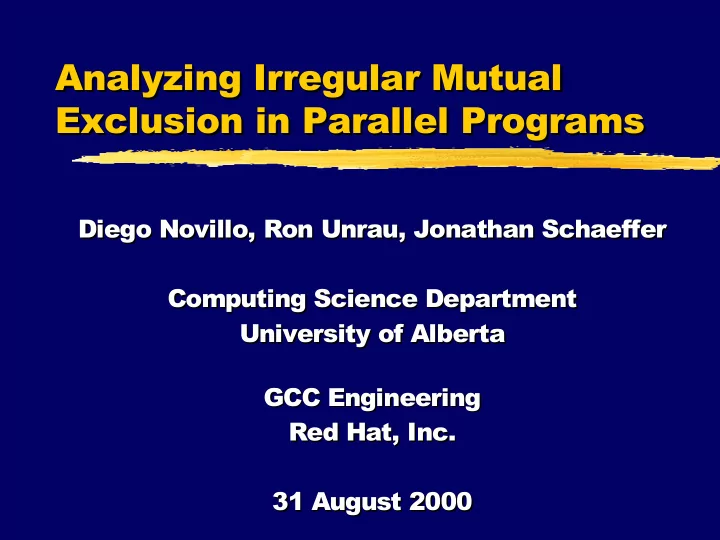

Analyzing Irregular Mutual Analyzing Irregular Mutual Exclusion in Parallel Programs Exclusion in Parallel Programs Diego Novillo, Ron Unrau, Jonathan Schaeffer Diego Novillo, Ron Unrau, Jonathan Schaeffer Computing Science Department Computing Science Department University of Alberta University of Alberta GCC Engineering GCC Engineering Red Hat, Inc. Red Hat, Inc. 31 August 2000 31 August 2000
Statement of Problem Statement of Problem ❚ Given a statement Given a statement s s and a lock variable and a lock variable L L , does , does s execute under the protection of lock execute under the protection of lock L L ? ? s ❙ always always s s is protected by is protected by L L ❙ never never or or sometimes sometimes s s is is not not protected by protected by L L ❚ Existing analysis techniques are based on Existing analysis techniques are based on structural definition of mutex regions. structural definition of mutex regions. ❚ We propose a dataflow based definition that can We propose a dataflow based definition that can identify irregularly shaped regions. identify irregularly shaped regions. EuroPar 2000 Analyzing Irregular Mutual Exclusio 2
Structure-based Mutex Structure-based Mutex Region Recognition Region Recognition statements lock/unlock statements ❚ lock/unlock act like begin/end block act like begin/end block delimiters. delimiters. 1: lock(L); lock(L); 1: 2: s1; 2: s1; ❚ Mutex regions are single- Mutex regions are single- 3: while (expr) { 3: while (expr) { entry, single-exit blocks. entry, single-exit blocks. 4: s2; 4: s2; 5: s3; 5: s3; ❚ Dominance information is Dominance information is 6: s4; 6: s4; used to determine extent of used to determine extent of 7: } 7: } mutex region. mutex region. 8: s5; 8: s5; 9: unlock(L); unlock(L); 9: ❚ There is one mutex region There is one mutex region spanning statements M(L) spanning statements M(L) . 2-9 . 2-9 EuroPar 2000 Analyzing Irregular Mutual Exclusio 3
Problems with Structural Problems with Structural Definition Definition ❚ A structural analyzer will A structural analyzer will not discover the mutex not discover the mutex 1: 1: lock(L lock(L 1 ); 1 ); regions in this case. regions in this case. 2: s1; 2: s1; 3: while (expr) { 3: while (expr) { ❚ The lock is released briefly The lock is released briefly 4: s2; 4: s2; to execute s3 . to execute s3 . 5: 5: unlock( unlock(L L); ); 6: s3; 6: s3; ❚ There is 1 mutex region There is 1 mutex region 7: 7: lock(L lock(L 2 ); 2 ); with multiple entry and exit with multiple entry and exit 8: s4; 8: s4; points: points: 9: } 9: } 10: s5; 10: s5; M(L 1 M(L 1 ,L ,L 2 2 ) = {2, 3, 4, ) = {2, 3, 4, 5 5, 8, , 8, 11: unlock( unlock(L L); ); 11: 9, 10, 11 11} } 9, 10, EuroPar 2000 Analyzing Irregular Mutual Exclusio 4
Dataflow-based Mutex Dataflow-based Mutex Region Recognition Region Recognition ❚ Problem is reduced to that of computing reaching definitions for each lock variable L ❚ Synopsis ➀ lock(L)/unlock(L) operations contain a definition for L . ➁ Every other node in the flowgraph contains a use of L . ➂ A node is protected by L if and only if all reaching definitions for L come from lock nodes. ❚ Every lock(L) defines a mutex region with all the nodes reached by its definition of L . ❚ Regions with common nodes are merged. ❚ Mutex regions may have multiple entry and exit points. EuroPar 2000 Analyzing Irregular Mutual Exclusio 5
Lock Picking Lock Picking ❚ Mutex analysis is part of the CSSAME form. Mutex analysis is part of the CSSAME form. ❚ Allows removal of superfluous conflicts that Allows removal of superfluous conflicts that cannot occur because of synchronization. cannot occur because of synchronization. ❚ Lock picking examines every lock node in the Lock picking examines every lock node in the program. program. ❚ If every entry node of a mutex region contains If every entry node of a mutex region contains no conflicts for its lock variable, the region locks no conflicts for its lock variable, the region locks can be removed. can be removed. EuroPar 2000 Analyzing Irregular Mutual Exclusio 6
Lock Picking Lock Picking parloop (p, 1, N) { (p, 1, N) { parloop GOAL GOAL for (i = 0; i < M; i++) { for (i = 0; i < M; i++) { Remove Remove lock lock (R); (R); for (j = 0; j < N; j++) { for (j = 0; j < N; j++) { unnecessary lock unnecessary lock sum_reduction(a[i][j]); sum_reduction(a[i][j]); operations operations } } unlock unlock (R); (R); } } } } sum_reduction(double x) sum_reduction(double x) { { Always protected by Always protected by lock lock (S); (S); lock R nested lock nested lock lock R SUM = SUM + x; SUM = SUM + x; unlock unlock (S); (S); } } EuroPar 2000 Analyzing Irregular Mutual Exclusio 7
Conclusions Conclusions ❚ We presented a new analysis to identify and We presented a new analysis to identify and validate irregular mutex synchronization validate irregular mutex synchronization patterns. patterns. ❚ Using this analysis together with the CSSAME Using this analysis together with the CSSAME form, it is possible to detect and remove form, it is possible to detect and remove unnecessary lock operations. unnecessary lock operations. EuroPar 2000 Analyzing Irregular Mutual Exclusio 8
Recommend
More recommend